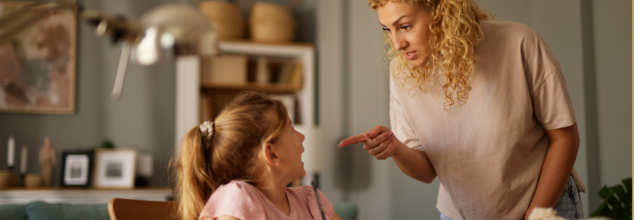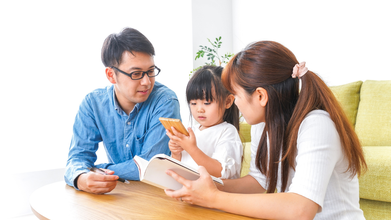- Health Conditions A-Z
- Health & Wellness
- Nutrition
- Fitness
- Health News
- Ayurveda
- Videos
- Medicine A-Z
- Parenting
- Web Stories
Cursing Around Kids: Does It Cause Harm?

Cursing Around Kids: Does It Cause Harm?
While the f-word becoming more normal than a 'hi', casual swearing has become somewhat normalized, the issue of whether parents should curse in front of their children has now become more relevant than ever. This has caused quite a debate among parents, educators, and psychologists regarding the effects of this behavior on children.
Some say it does not matter, and others are worried about its impact on children's behavior and social skills in the long run. So, what is the verdict? Let's understand the issue and explore whether or not cursing in front of kids is really as problematic as it might seem.
Social Implications of Parents Swearing
Parents often find themselves in situations where frustration or stress leads them to use colorful language. From a burnt dinner to a traffic jam, expletives sometimes slip out, and many wonder whether their kids are paying attention. Indeed, children are like sponges—absorbing everything they hear, see, and experience. So, when they overhear their parents swearing, what does it mean for them?
Some parents worry that exposure to bad language from their children will lead down a slippery slope of further inappropriate behavior, like "gateway drugs" to serious problems. Others worry their children will learn to throw around swear words without good judgment, and then there'll be social consequences, including embarrassing moments in school or conflicts with teachers. It's easy to see how this could become an anxiety point for parents.
A 2011 paper on Pediatrics assessed the nature and scope of children's perceptions of swearing in games and videos to television programming by establishing whether exposure to more profanity leads kids into engaging in more aggression than children not exposed. Indeed, moderate positive relationship occurred; that is to say that casual use of cursing may actually affect language as perceived, behavior as perceived and perception on social norms.
However, it is important to understand that the effect of listening to curse words is quite situation-specific and depends more upon the context in which those words are used as well as the frequency by which children are exposed to these words. For instance, when children are exposed occasionally with stressful or private moments, that isn't as harmful as a habitual use of abusive or degrading words.
Language of Swearing: Does It Harm or Help?
For a moment now, research has shown otherwise-indeed, that people generally believe to be the converse-swearing does not have dire effects as most people view it. In fact, within controlled contexts, profanities have been associated with positives in language development.
Experts have demonstrated that those capable of fluently using what society will have termed curse words are significantly able to give appropriate expression of complex emotions thereby suggesting that swearing, although careful should be reflective of linguistic and emotionality creativity.
On the other hand, though, some research suggests swearing can also be a way of having a cathartic release. Swearing to relieve a moment of suffering or annoyance has been established to be a pain enhancer. This may suggest swearing in the presence of kids, within reasonable limits, can represent a harmless emotional release for their parents.
However, it would be vital to consider the language being employed. Though slurs used for emphasis or moments of frustration may not do any harm, the intention behind some words can go a long way. Using derogatory terms or slurs in the presence of children is a way of reinforcing harmful societal beliefs and negative stereotypes.
This was illustrated in a 2007 study published in The Journal of Early Adolescence, which discovered that being exposed to homophobic slurs was associated with increased stress, anxiety, and depression in children. Therefore, although casual swearing is not by itself damaging, hate-filled language is.
What About the Kids?
One of the primary reasons parents worry is whether their kids will adopt the bad language they hear. Children, especially those under 5 years old, are very prone to mimicking everything they hear. If the young child hears their parents uttering these words most of the time, then they are likely to say them as well, without fully understanding their meanings or appropriateness for use. Such situations often lead to embarrassment or awkwardness, especially in places such as school or social events.
However, as children grow older and acquire a better understanding of the language, they start grasping the subtlety of social norms. This is when parents often observe that children who are frequently exposed to occasional swearing are not imitating the behavior themselves. Some children, even those who hear swearing from their parents, do not use it, especially if it is not taboo anymore. The concept is that when the language is not considered a "forbidden fruit," it loses its allure.
Basically, when the swearing gets out of proportion or done towards children, then there is a risk of resultant damage. Experts say that only occasional use of curse words by oneself in private won't do much harm. The actual problem is present when the habit becomes part of regular communication or if it is used in a hostile or to belittle others' manner. Using swelling as the punitive measure or lowering the prestige of children is highly not acceptable in any case.
It's about balance, like most things in parenting. Parents who use the word in a non-abusive manner and in proper context are unlikely to find anything wrong with their children's development. In fact, some research suggests that children who hear their parents swear have a better understanding of language and emotional expression.
So, is cursing in front of kids a bad idea? Not necessarily, if done thoughtfully and in moderation. The real problem is not the words themselves, but the context in which those words are used and the intentions behind them. Swearing is a natural part of language, but when used indiscriminately or abusively, it can be offensive.
Parents should aim to model respectful communication, and always be mindful of how and when they use language in front of their children. Ultimately, the key lies in teaching children about appropriate language and the importance of using words thoughtfully and responsibly.
Parenting Habits That Creates Struggling Adults, According To Child Psychologist

Credits: Canva
Raising a child is not the easiest job. In fact, everyday feels like a new test. Somedays you would find yourself jumping to finish cleaning your child's toys even when you asked them to do. On other days, you would have a meltdown, but will have to manage to stop it.
But while you do all of these, there may be certain actions that may make your child into a struggling adult.
Child psychologist, and professor Daniel J Moran, of Touro University New York, told Newsweek, "Parents...are working overtime to make their children's lives smooth and happy. The intention is love, [but[ the outcome is often dependency."
This happens when parents remove discomfort from a child's life. The above example of the parent picking up child's toys is one such instance. If one has to apply science into it, children learn confidence by experiencing consequences and discovering that they can handle it. If parents get everything done for them, they will never know if they could handle a certain situation.
Moran says that true resilience comes from "hearing to stay present, feel the hard stuff and keep moving toward what matters."
Three Common Habits And Actions Of Parents That Could Take Away Their Child's Independence And Make Them A Struggling Adult
Fix Instead of Coach: This happens when parents jump in to solve every problem on their own. This teaches the kids that they do not have to work things on their own. Instead of fixing, parents must coach their kids, guide them into solving things.
Overpraising: While appreciating one's effort, especially when a child does something big for the first time is important. However, continuously praising your child on a day to day basis, without having to achieve something new or special could remove the learning value of effort and feedback. For every activity that a child does, praise is not the only feedback, it could also be critical in nature.
Overscheduling: Parents often feel the urge to teach their child everything, especially the things they wanted to learn as kids, but never got to. However, it leaves little room for boredom, which is dangerous, as Moran says that boredom is a place, "where creativity and self direction grow".
So, What Can Parents Do?
Moran says that the parents should let their kids "struggle safely". Parents can also model questions of acceptance of mistakes and ask reflective questions, such as "who do you want to be right now?"
"If we want confident, capable young adults, we have to let kids practice being uncomfortable,” Moran says. "Confidence doesn’t come from constant praise, but comes from persistence, problem-solving and purpose. A little discomfort today can build the psychological flexibility they’ll need tomorrow.”
Dr Samantha Whiten, clinical psychologist, owner of Best Life Behavioral Health tells Newsweek that overhelping often encourages overdependence. " Doing everything for your child when they can physically do things for themselves... trains them to depend on you for everything versus being proud and confident in what they can master on their own,” she says.
So Whiten recommends a steady approach that can build confidence. The first step is to demonstrate the task and let the child try it while you observe. Then leave the room, observe from afar, because you leaving the room would mean that you are confident in your child.
Fewer Children Are Now Allergic To Peanuts, Study Reveals The Key To Lesser Allergies In Kids

(Credit-Canva)
Allergies are common, and anyone can develop them at any age. An allergy is an immune response that occurs when the body mistakes a harmless substance for a threat.. This then causes your body to overreact, leading to symptoms that range from mild to life threatening. One of the most common allergens is peanuts. However, recent studies have shown that there is a way we can lower the risk of developing this allergy.
A new study has found that food allergies in young children have fallen sharply since 2017, when the guidelines for introducing common allergens into the child’s diet were changed.
For many years, experts advised parents to avoid giving common allergens to their babies because allergy rates were climbing. However, a major study in 2015 discovered that feeding peanuts to infants could slash their risk of developing a peanut allergy by over 80%. Based on this finding, the National Institute of Allergy and Infectious Diseases issued official guidelines in 2017 recommending this early-introduction approach.
How Much Did Peanut Allergy Cases Go Down?
The study, published in the journal Pediatrics, analyzed food allergy rates in children under the age of three before and after the 2017 guidelines were issued. The results showed a significant decline:
- Overall food allergies dropped to 0.93% between 2017 and 2020, down from 1.46% between 2012 and 2015.
- This represents a 36% reduction in all food allergies.
- The decline was mainly driven by a huge 43% drop in peanut allergies.
- The study noted that eggs have now taken over peanuts as the most common food allergen in young children.
Can People Outgrow Allergies?
While the study didn't directly track what infants were fed, the data is highly encouraging because the drop in allergies happened right after the new guidelines were put into effect.
While the results are highly encouraging, the study noted that many doctors and parents still haven't fully adopted the new advice. Surveys show that full compliance remains low among both pediatricians and caregivers.
The study also found shifts in the racial and ethnic breakdown of children diagnosed with food allergies. Compared to the pre-guidelines period, there were fewer food-allergic children who were Black, Asian or Pacific Islander, and Hispanic in the post-guidelines period, with an increased proportion of White children. The researchers noted that these changes might reflect differences in how easily different groups can access healthcare and information about the new feeding practices.
Experts see this as a major public health success. Experts see this as a major public health success, noting that the data provide real-world evidence of how a simple public health recommendation can improve children’s health. This is particularly important for peanut allergies, which 80% of people never outgrow and can be life-threatening.
While the reasons for food allergies are still not completely understood, some scientists believe factors like higher rates of C-section births, early use of antibiotics, and increasingly sanitized environments may still play a role. However, the data suggests that early introduction is a powerful tool to protect children.
Stacey Hatfield, Australian Food Influencer, Dies Of A Rare Pregnancy Complication

Credits: GoFundMe
While most pregnancies normally and do not have any serious complications, notes Johns Hopkins Medicine, sometimes rare complications can occur and it can then interfere with normal fetal development. In such a case, Australian nutritionist and social media influencer Stacey Hatfield tragically passed away. Her husband described it as an “extremely rare complication” during childbirth. The 30-year-old Melbourne native was known for promoting toxin-free living and wholesome recipes under the handle @naturalspoonfuls, where she had more than 17,000 followers.
Hatfield’s pregnancy had been filled with joy and anticipation. She and her husband, Nathan Warnecke, were just two months away from celebrating their first wedding anniversary when she went into labour at home on September 29.
She gave birth to a healthy baby boy, Axel, fulfilling what Warnecke said was her “biggest dream in life — to be a mum.” But moments after delivering her son, the “unimaginable” occurred.
A Tragic Turn After Birth
According to Warnecke, Hatfield developed an “unforeseen and extremely rare complication” immediately after childbirth. She was rushed to the hospital, where medical staff did everything they could to save her life.
“Hospital staff were amazing and did the utmost to help, but ultimately nothing could be done despite their best efforts,” Warnecke said in a social media post announcing her passing. “Words can’t do justice to how devastating this is for myself and everyone that knew and loved her.”
He shared that Hatfield’s final moments were filled with love and happiness as she held her newborn son in her arms. “She held Axel when he was born, nursed him, saw that he was a boy, and loved him,” he wrote. “She loved him so much and still continues to love him.”
Remembering a “Lighthouse in the Storm”
Warnecke, who called Stacey his “beautiful wife, soulmate, and best friend,” said her passing has left a void that words cannot fill. “I knew Stace for nine amazing years — she was the light of my life and the reason I got up in the morning,” he said. “She was my lighthouse in the storm, and the world is less bright without her in it.”
He described her as “the most beautiful, loving, caring, hardworking, disciplined, intelligent, and trustworthy human being” he had ever known.
Community Support for the Family
In the wake of the tragedy, family, friends, and the wider community have come together to support Warnecke and baby Axel. A GoFundMe page has raised more than $20,000 to help cover funeral expenses, childcare, and household costs as the grieving family adjusts to life without Stacey.
What Are Some Of The Rarest Pregnancy Complications That Can Kill The Mother?
- Lower Urinary Tract Obstruction: a rare fatal condition that occurs when there is a blockage in the urinary tract of a developing fetus. In this condition, the urine cannot be drained, and the fluid around the fetus decreases.
- Amniotic Fluid Embolism: this is when amniotic fluid, cells, hair, or fecal matter of the baby enters the mother's blood circulation and leads to conditions like Disseminated Intravascular Coagulation (DIC).
- Pulmonary Embolism: this happens when the blood in mother becomes more coagulable and could sometimes form blood clots, known as thrombosis.
- Uterine Rupture: it is a rare complication, where the risk of it happening is less than 1%. If it occurs, it usually happens during labor.
© 2024 Bennett, Coleman & Company Limited

